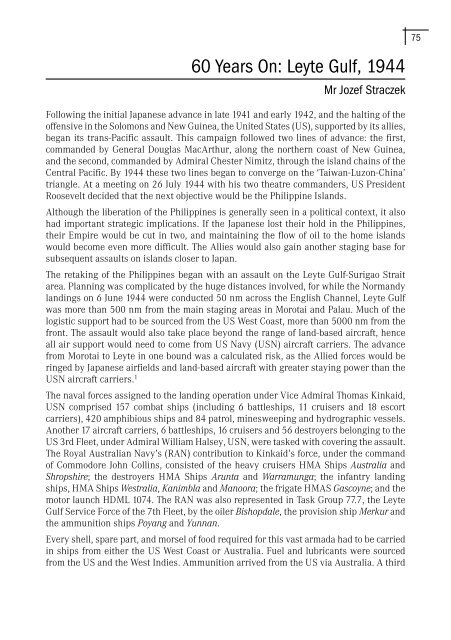Australian Maritime Issues 2005 - Royal Australian Navy
Australian Maritime Issues 2005 - Royal Australian Navy
Australian Maritime Issues 2005 - Royal Australian Navy
Create successful ePaper yourself
Turn your PDF publications into a flip-book with our unique Google optimized e-Paper software.
75<br />
60 Years On: Leyte Gulf, 1944<br />
Mr Jozef Straczek<br />
Following the initial Japanese advance in late 1941 and early 1942, and the halting of the<br />
offensive in the Solomons and New Guinea, the United States (US), supported by its allies,<br />
began its trans-Pacific assault. This campaign followed two lines of advance: the first,<br />
commanded by General Douglas MacArthur, along the northern coast of New Guinea,<br />
and the second, commanded by Admiral Chester Nimitz, through the island chains of the<br />
Central Pacific. By 1944 these two lines began to converge on the ‘Taiwan-Luzon-China’<br />
triangle. At a meeting on 26 July 1944 with his two theatre commanders, US President<br />
Roosevelt decided that the next objective would be the Philippine Islands.<br />
Although the liberation of the Philippines is generally seen in a political context, it also<br />
had important strategic implications. If the Japanese lost their hold in the Philippines,<br />
their Empire would be cut in two, and maintaining the flow of oil to the home islands<br />
would become even more difficult. The Allies would also gain another staging base for<br />
subsequent assaults on islands closer to Japan.<br />
The retaking of the Philippines began with an assault on the Leyte Gulf-Surigao Strait<br />
area. Planning was complicated by the huge distances involved, for while the Normandy<br />
landings on 6 June 1944 were conducted 50 nm across the English Channel, Leyte Gulf<br />
was more than 500 nm from the main staging areas in Morotai and Palau. Much of the<br />
logistic support had to be sourced from the US West Coast, more than 5000 nm from the<br />
front. The assault would also take place beyond the range of land-based aircraft, hence<br />
all air support would need to come from US <strong>Navy</strong> (USN) aircraft carriers. The advance<br />
from Morotai to Leyte in one bound was a calculated risk, as the Allied forces would be<br />
ringed by Japanese airfields and land-based aircraft with greater staying power than the<br />
USN aircraft carriers. 1<br />
The naval forces assigned to the landing operation under Vice Admiral Thomas Kinkaid,<br />
USN comprised 157 combat ships (including 6 battleships, 11 cruisers and 18 escort<br />
carriers), 420 amphibious ships and 84 patrol, minesweeping and hydrographic vessels.<br />
Another 17 aircraft carriers, 6 battleships, 16 cruisers and 56 destroyers belonging to the<br />
US 3rd Fleet, under Admiral William Halsey, USN, were tasked with covering the assault.<br />
The <strong>Royal</strong> <strong>Australian</strong> <strong>Navy</strong>’s (RAN) contribution to Kinkaid’s force, under the command<br />
of Commodore John Collins, consisted of the heavy cruisers HMA Ships Australia and<br />
Shropshire; the destroyers HMA Ships Arunta and Warramunga; the infantry landing<br />
ships, HMA Ships Westralia, Kanimbla and Manoora; the frigate HMAS Gascoyne; and the<br />
motor launch HDML 1074. The RAN was also represented in Task Group 77.7, the Leyte<br />
Gulf Service Force of the 7th Fleet, by the oiler Bishopdale, the provision ship Merkur and<br />
the ammunition ships Poyang and Yunnan.<br />
Every shell, spare part, and morsel of food required for this vast armada had to be carried<br />
in ships from either the US West Coast or Australia. Fuel and lubricants were sourced<br />
from the US and the West Indies. Ammunition arrived from the US via Australia. A third

















